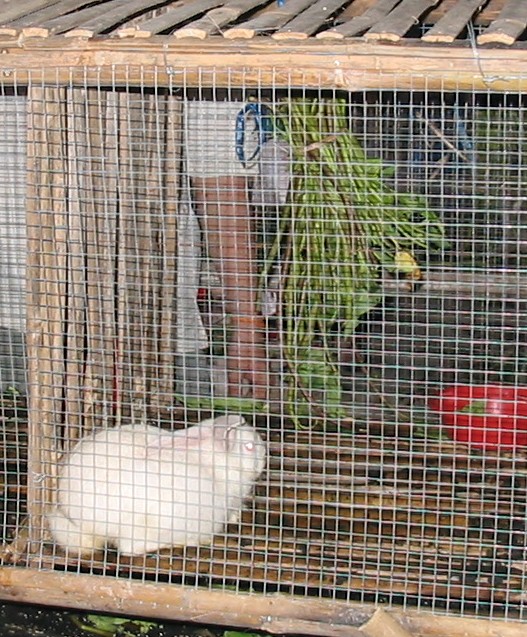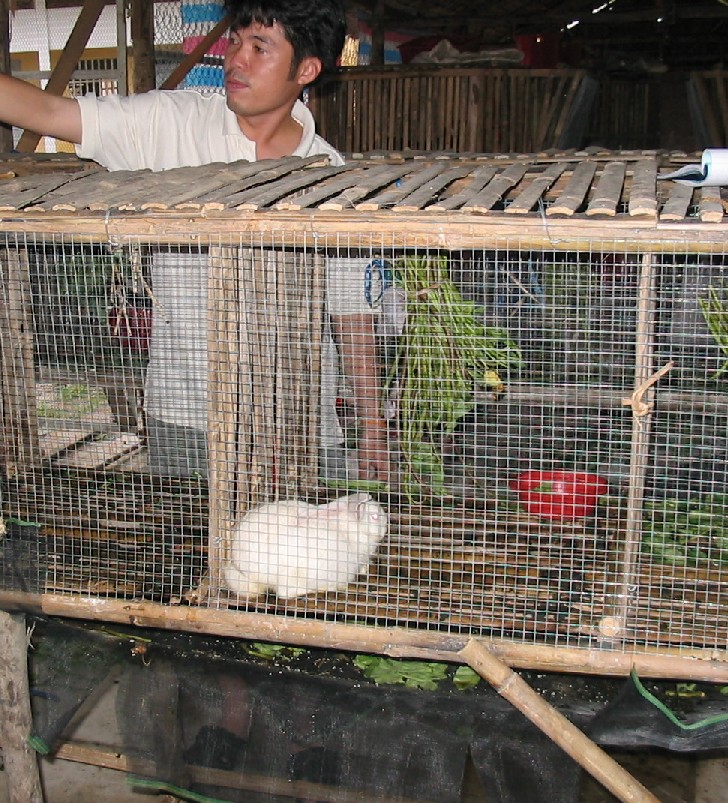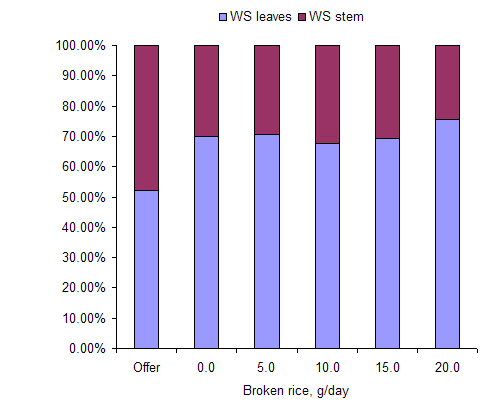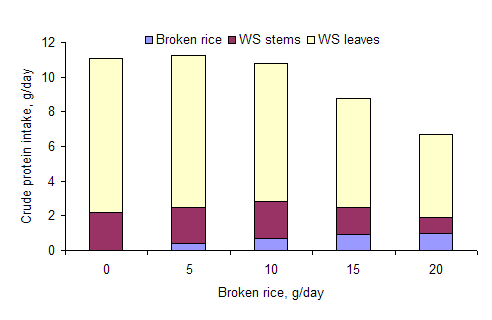Water spinach (Ipomoea aquatica) as a low-cost feed resource
for growing
rabbits
Hongthong
Phimmmasan
Xiengkhuang Province Agriculture and Forestry Office (PAFO),
Laos
hongthongp@yahoo.com
Abstract
Ten young rabbits averaging 416 g were allotted at random into five treatments consisting of rations based on fresh water spinach (Ipomoea aquatica) given at libitum and five levels of broken rice (0, 5, 10, 15 and 20 g/rabbit per day) to determine growth parameters and digestive indices during 30 days.
There was no significant effect of broken rice on growth performance of rabbits fed water spinach ad libitum. Although not significantly different from the other treatments, daily gains in weight of 22.1 and 22.7 g/day, were highest for animals fed 5 and 10 broken rice/day. There was no significant effect of broken rice on digestibility indices of rabbits fed water spinach ad libitum.
Water spinach as the only source of feed for growing rabbits appears to support acceptable growth rates of close to 20 g/day with a DM feed conversion of 2.7. This simple feeding system may be attractive for small-holder farmers in the tropics, due to the possibility to raise rabbits with a local resource (water spinach) that is easy to grow and needs no processing.
Key words: Broken rice, digestibility, growth,
rabbits, water spinach
Introduction
In most developing, tropical countries as Laos, Vietnam or Cambodia, farmers keep livestock like cows, buffaloes, pigs, fish and poultry for their main source of income. Small animals like chickens, ducks and rabbits are used for home consumption. However, productivity is low and there is a lack of feed resources, particularly in the dry season.
Some approaches to solve the main constraint of feed scarcity in general and protein sources in particular, have been directed toward the search of local feedstuffs. Rabbit husbandry is not an exception in this context, and there are some recent reports concerning the use of tropical foliage as source of protein for this specie (Akinfala et al 2003; Sarwatt et al 2003).
Water spinach (Ipomoea aquatica) is coming to play an important role for farmers in rural areas, because it is easy to plant and has a very high yield of biomass, which is rich in protein. The crude protein content in the leaves and stems can be as high as 32 and 18 % in dry basis, respectively (Ly Thi Luyen 2003). Water spinach is widely used for human food, but at the same time this vegetable can be given to rabbits, pigs and poultry. For these reasons, it is considered that water spinach can be a low cost feed for rabbits at smallholder farmer level.
The objective of this communication is to report preliminary observations concerning the use of water spinach as the major ration constituent for growing rabbits, and to determine the effect of supplementing it with small amounts of broken rice as a readily digestible source of carbohydrate.
Materials and methods
Ten young rabbits averaging 416 g in live weight were allotted at random into five treatments consisting of rations based on fresh water spinach (Ipomoea aquatica) given at libitum and five levels of broken rice (0, 5, 10, 15 and 20 g/rabbit per day) to determine growth parameters and digestive indices during a 30 day trial.
The experiment was carried out from 2 to 31 August 2003 at the
research station of the An Giang University. Average air
temperature at the experimental area, ranged as follows: 6 am,
27.3 ± 1.55 oC, 12 am, 31.8 ± 2.92
oC, and 6 pm, 27.7 ± 2.37
oC.
Experimental design and treatments
The design was a randomized block with blocks being the replications (see Table1)
|
Table 1: Layout of the experiment |
|||||
|
|
Broken rice, g/day |
||||
|
|
0 |
5 |
10 |
15 |
20 |
|
Block 1 (cages 1 to 5) |
1 |
4 |
5 |
2 |
3 |
|
Block 2 (cages 6 to 10) |
10 |
6 |
7 |
8 |
9 |
Feed characteristics
The broken rice used in the trial had a low content of ash and crude protein (Table 2). On the other hand, the leaves from the water spinach were rich in crude protein, nearly twice the value corresponding to the stems from this same plant. The leaves and stems from water spinach used in the experiment were the terminal branches and the crude protein (Nx6.25) ratio of leaves to stems in the dry material was 1.75:1.
|
Table 2: Feed characteristics (% in dry
basis, except for DM which is on fresh basis) |
||||
|
|
DM |
Ash |
Organic matter |
Crude protein |
|
Broken rice |
93.1 |
0.78 |
99.0 |
8.31 |
|
Water spinach |
|
|
|
|
|
Leaves |
12.9 |
11.2 |
88.8 |
31.9 |
|
Stems |
8.43 |
14.4 |
85.6 |
18.2 |
|
Crude protein equals Nx6.25. |
||||
Feeding and management of
animals
The water spinach was bought from farmers in the neighborhood of the University. The broken rice was from the local market. The water spinach (leaves attached to stems) was hung in the cage, by tying the stem portion to a bamboo stick (Photo 1).

Photo 1: Hanging the water spinach from the roof of the cage
The foliage was offered to the animals at least two times a day beginning in the morning at 6:30 am. Observations, mainly at midday (12:00 m) and in the evening (5:30 pm), were done to ensure the permanent availability of water spinach. The broken rice was served to the animals in a small bowl every morning, when feed refusals from the previous day were recorded. The proportions of leaves and stems (fresh basis) in the water spinach were recorded daily in the feed offered and refused. The animals were weighed every five days during the trial.
Animal housing
The cages were made of bamboo strips and metal wire mesh (Photo 2), with an elevation from the floor of approximately 0.75 m. The dimensions of each cage were: width 25 cm, length 25 cm and height 25 cm. Two batteries of five cages each were housed in an open shed at the University Campus.

Photo 2: One of the battery of 5 cages used to house the rabbits
Digestibility studies
Faeces were collected on days 10 to 15 to determine digestibility indices by the acid-insoluble ash technique (Van Keulen and Young 1977). Feed refusals were collected every day and kept frozen in plastic bags until analysis. At the end of the collection period, feed refusals and faeces were mixed thoroughly by hand and pooled, ground in a coffee grinder in the fresh state and, thereafter, representative samples were used for chemical analysis.
Chemical analyses
Chemical analyses of the diets and faeces were undertaken following the methods of AOAC (1990) for ash and N. The DM content was determined using the microwave method of Undersander et al (1993). pH (glass electrode) was measured on the fresh faeces, which were also analyzed for total short chain fatty acids (SCFA) by steam distillation in a Markham apparatus followed by titration of the distillate with NaOH 0.01 N. Water extractability was determined by the methods described by Ly and Preston (2001). Ash from feed and faeces was treated with HCl 2 N, then combusted again in a muffle furnace for the estimation of acid insoluble ash, following the method of Van Keulen and Young (1977) as outlined by Ly et al (2002).
Digestibility indices were calculated by standard procedures using acid insoluble ash as inert marker.
Statistical analysis
The data were subjected to analysis of variance (Steel and
Torrie 1980) using the General Linear Model (GLM) option of the MINITAB
software (Release 13.31, 2000).
Results and discussion
Feed intake
The rabbits offered the higher amounts of broken rice did not eat all that was offered (Table 3), and this was especially evident (P<0.001) when broken rice was given at levels of 15 and 20 g/day per animal. Intake of water spinach was reduced at offer levels of broken rice above 5 g/day (Figure 1). The rabbits selected more of the leaves than the stems (Figure 2) but the proportion was not affected by the level of broken rice. The total DM intake was reduced at the highest level of broken rice supplementation. Total crude protein intake was lower with broken rice offer levels of 15 and 20 g/day, compared with levels of 5 and 10 g/day (Table 3 and Figure 3).
|
Table 3. Feed intake pattern of rabbits fed water spinach ad libitum and graded levels of broken rice |
|||||||
|
|
0 |
5 |
10 |
15 |
20 |
SEM |
Prob. |
|
Feed offered, g DM/day |
|||||||
| Leaves |
40.2 |
38.1 |
36.4 |
31.8 |
19.7 |
1.8 |
0.001 |
| Stems |
36.4 |
34.5 |
33.0 |
28.8 |
17.3 |
1.6 |
0.001 |
| Broken rice |
0 |
4.65 |
9.31 |
14.0 |
18.6 |
|
0.001 |
| Total |
76.6 |
77.3 |
78.8 |
74.6 |
55.6 |
3.31 |
0.001 |
|
Feed refusal, g DM/day |
|
|
|
|
|||
| Leaves |
12.5 |
10.8 |
11.8 |
12.2 |
4.2 |
1.0 |
0.001 |
| Stems |
24.5 |
23.1 |
21.2 |
20.1 |
11.9 |
1.3 |
0.001 |
| Broken rice |
0.0 |
0.0 |
1.0 |
3.2 |
6.5 |
|
0.001 |
| Total |
37.0 |
33.9 |
33.0 |
32.3 |
16.1 |
2.09 |
0.001 |
|
Feed intake, g DM/day |
|
|
|
|
|||
| Leaves |
27.6 |
27.3 |
24.7 |
19.6 |
15.0 |
1.5 |
0.001 |
| Stem |
11.9 |
11.4 |
11.8 |
8.7 |
4.9 |
0.7 |
0.001 |
| Broken rice |
0.0 |
4.7 |
8.3 |
10.8 |
12.1 |
0.5 |
0.001 |
| Total |
39.5 |
43.4 |
44.8 |
39.1 |
31.9 |
2.2 |
0.001 |
|
Crude protein intake, g/day |
|
|
|
|
|||
| Leaves |
8.90 |
8.79 |
7.94 |
6.31 |
4.82 |
0.47 |
0.001 |
| Stems |
2.17 |
2.08 |
2.14 |
1.58 |
0.89 |
0.13 |
0.001 |
| Broken rice |
0.00 |
0.39 |
0.69 |
0.90 |
1.00 |
0.04 |
0.001 |
| Total |
11.1 |
11.3 |
10.8 |
8.79 |
6.71 |
0.57 |
0.001 |

Figure 1: DM intake of WS leaves, WS stems and broken rice according to levels of broken rice offered

Figure 2: Proportions of leaves and
stems (DM
basis) in the water spinach offered and consumed according
to offer level of supplementary broken rice

Figure 3: Quantities of crude protein consumed as leaves and stems of water spinach and as broken rice
Growth and feed conversion
Neither final weight (Table 5) nor mean daily gain (Figure 4) was significantly influenced by the inclusion of graded levels of broken rice in the offered feed. Feed conversion was similarly unaffected by supplementation. Values for both growth and feed conversion were at an acceptable level, and were superior to reported performance data for rabbits in Nigeria (9 to 11 g/day and 4.9 to 6.0 DM conversion; Akinfala et al 2003), Tanzania (13 to 19 g/day and 3.8 to 4.2 DM conversion; Sarwatt et al 2003) and Vietnam (10.0 g/day and 7.0 DM conversion; Nguyen Quang Suc et al 1996; 16 to 22 g/day and 4.1 to 4.7 DM conversion; Dinh Van Binh et al 1991).
|
Table 5. Performance traits of rabbits fed ad libitum water spinach and graded levels of broken rice |
||||||
|
|
Broken rice, g/day |
|
||||
|
|
0 |
5 |
10 |
15 |
20 |
SEM/Prob. |
| Live weight, g |
|
|
|
|
|
|
| Initial |
453 |
428 |
350 |
405 |
408 |
54/0.75 |
| Final |
978 |
1110 |
1045 |
897 |
1092 |
193/0.93 |
| Daily gain |
18.1 |
22.1 |
22.7 |
16.4 |
22.4 |
4.96/0.85 |
| DM Feed conversion |
2.65 |
1.89 |
1.61 |
1.98 |
2.07 |
0.52/0.72 |

Figure 4. Growth rate of rabbits fed water
spinach ad libitum and graded levels of broken
rice
Digestibility studies
Increasing the level of broken rice in the diet appeared to result in a lower pH (Table 6) and a significant increase in the concentration of SCFA in the faeces (Figure 4). The implication from these observations is that the SCFA must have arisen from fermentation of the starch in the broken rice. On the other hand, none of the digestibility indices examined in the current study appeared to be affected by the level of broken rice consumed by the rabbits.
|
Table 6.
Faecal characteristics and digestibility indices in rabbits fed ad libitum
water
|
|||||||
|
|
Broken rice, g/day |
||||||
|
0 |
5 |
10 |
15 |
20 |
SEM |
Prob |
|
|
Faecal characteristics |
|||||||
|
pH |
6.1 |
5.9 |
5.6 |
6.1 |
5.4 |
0.3 |
0.30 |
|
DM, % |
31.9 |
40.4 |
45.9 |
33.0 |
38.6 |
11.4 |
0.89 |
|
SCFA, mmol/100 g DM |
44.5 |
59.0 |
72.4 |
79.7 |
100.3 |
25.2 |
0.89 |
|
Digestibility, % |
|||||||
|
DM |
84.7 |
84.8 |
85.0 |
89.3 |
86.5 |
3.2 |
0.82 |
|
Ash
|
76.7 |
73.1 |
75.8 |
74.9 |
75.0 |
2.9 |
0.92 |
|
Organic matter |
88.4 |
86.0 |
85.8 |
90.3 |
87.4 |
3.9 |
0.91 |
| Crude protein |
79.6 |
77.8 |
76.4 |
79.2 |
77.4 |
5.4 |
0.99 |
Figure 4: Relationship
between intakes of supplementary broken rice and concentration
of short chain fatty acids in the faeces of rabbits fed ad libitum water spinach
Mortality
One rabbit on the 20 g/day broken rice level developed severe diarrhoea and died after 2 weeks on the experiment. The symptoms and observations of highest levels of SFCA in faeces on this diet suggest that the cause may have been undigested starch reaching the large intestine, providing a substrate for bacterial fermentation.
Conclusions
- Fresh water spinach as the only source of feed for growing rabbits appears to support acceptable growth rates of close to 20 g/day and an excellent feed conversion of 2.7 g DM per g live weight gain.
- This simple feeding system may be attractive for small-holder farmers in the tropics, due to the possibility to raise rabbits with a local resource (water spinach) that is easy to grow and needs no processing.
Acknowledgments
First of all I would like to express my gratitude to the MEKARN program under the SIDA-SAREC Project for providing us an opportunity and budget to learn and conduct a mini-project, which helped me to understand more about steps in planning and conducting an experiment. Special thanks are given to Dr T R Preston and to Dr J Ly for their supervision and support. The mini-project activities were very well organized and provided valuable suggestions and comments. Thanks are also given to Mr Chay Ty and Mr San Thy, as facilitators for providing practical support and laboratory assistance. Without this support, I do not believe I would have been able to carry out this experiment.
References
Akinfala E O, Matanmi O and Aderibigbe A O 2003 Preliminary studies on the response of weaner rabbits to whole cassava plant meal basal diets in the humid tropics. Livestock Research for Rural Development 15(4): http://www.cipav.org.co/lrrd/lrrd154/akin154.htm
AOAC 1990 Official methods of analysis. Association of Official Analytical Chemists. 15th edition. Arlington pp1290
Dinh Van Binh, Bui Van Chinh and Preston T R 1991 Molasses-Urea Blocks as supplements for rabbits. Livestock Research for Rural Development 3(2): http://www.cipav.org.co/lrrd/lrrd3/2/viet1.htm
Ly Thi Luyen 2003
Effect of the urea level on biomass production of water spinach (Ipomoea
aquatica) grown in soil and in water.
Ly J, Chhay Ty and Pok Samkol 2002 Studies on the use of acid insoluble ash as inert marker in digestibility trials with Mong Cai pigs. Livestok Research for Rural Development 14(5): http://www.cipav.org.co/lrrd/lrrd14/5/ly145.htm
Ly J and Preston T R 2001 In vitro estimates of nitrogen digestibility for pigs and water-soluble nitrogen are correlated in tropical forages feeds. Livestock Research for Rural Development 13(11): http://www.cipav.org.co/lrrd/lrrd13/1/ly131.htm
Nguyen Quang Suc, Ly Thi Luyen and Dinh Van Binh 2000 Feeding systems for tropical rabbit production emphasizing root and bananas. Proceedings National Workshop-Seminar Sustainable Livestock Production on Local Feed Resources (Editors: T R Preston and R B Ogle). Ho Chi Minh City, Vietnam. http://www.mekarn.org/sarpro/suctuber.htm
Sarwatt S V, Laswai G H and Ubwe R 2003: Evaluation of the potential
of Trichanthera gigantea as a source of nutrients for rabbit diets under small
holder production system in Tanzania.
Steel R G D and Torrie J A 1980 Principles and Procedures of Statistics: a Biometrical Approach. McGraw-Hill Book Company (second edition) Toronto
